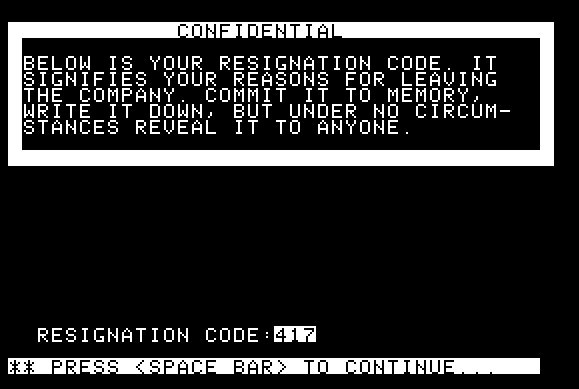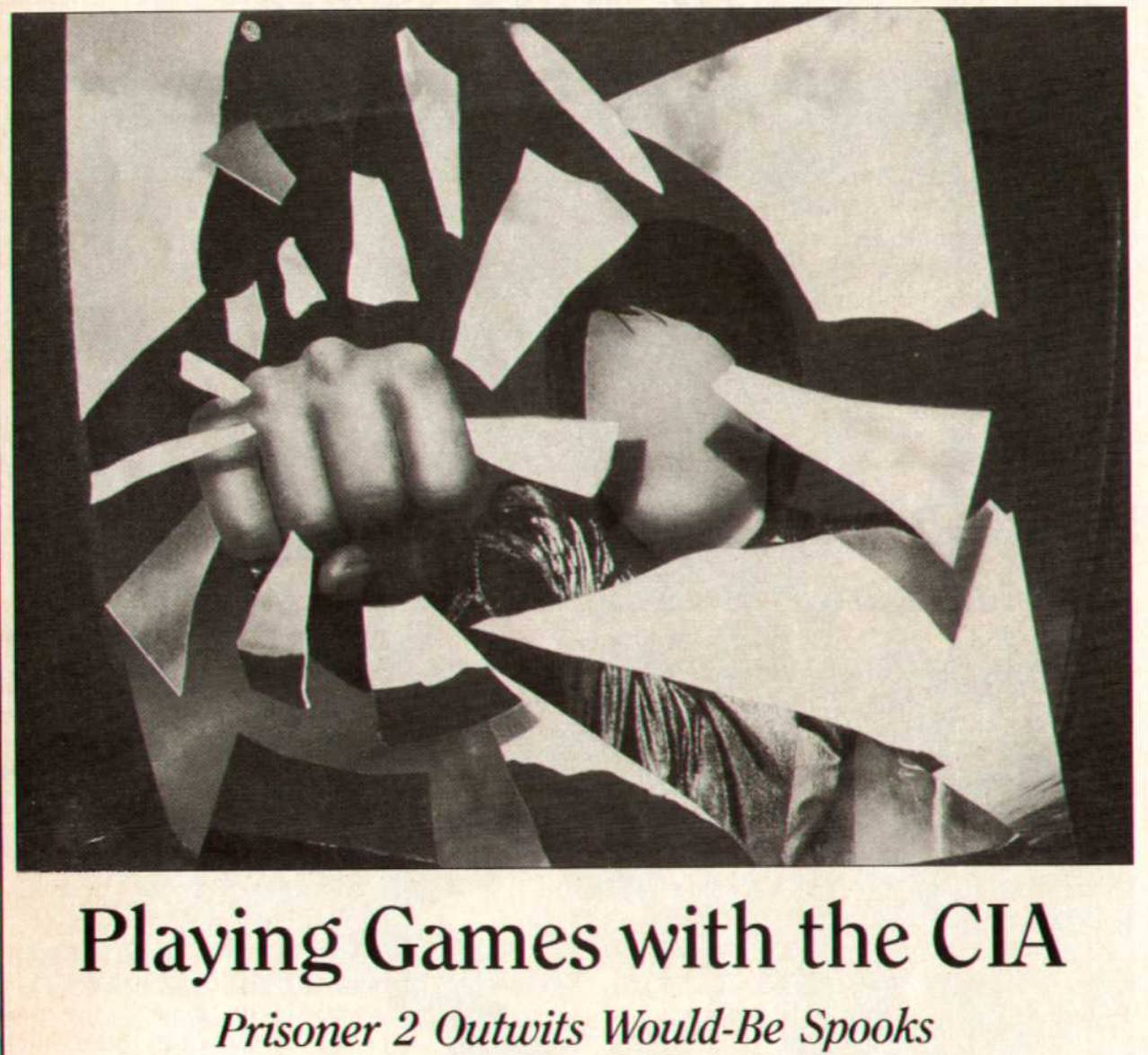By Dylan • 5 February 2021
Did you know that there’s a Prisoner video game? Neither did I until the last episode of our Prisoner run through on Inevitable: A Classic Sci-Fi Podcast. Originally Kiyan and I had slated to talk about this video game during the second Prisoner season, but then we started a blog and it became evident that this would be the perfect topic for a blog post.
This week’s post is the first in what I plan to be (should everything go well) a three part series leading into our fifth season of Inevitable where we cover the Prisoner miniseries that aired on AMC. The first post (this one) will serve as an introduction to the video game, the second will concentrate on my experience with the game and the third will be a conclusion post and discussion on certain elements that I feel warrant further discussion.
The Prisoner video game (which I will just refer to as The Prisoner from here on out) was released in 1980 for the Apple II by a company called Edu-Ware. Yes, that Apple II. Two years later Edu-Ware remade the game in full color with first person graphics. Yes, they turned an overhead game into a first person game. Weird. I know. For all intents and purposes though it’s the same game, but I prefer the text-adventure stylings of the first game. And, much to my disappointment, Edu-Ware was bought out in 1984 and slowly vanished in the next year. How sad.
The Prisoner is pretty difficult to play in [current year]. For legal reasons I shouldn’t tell you how to play it but I can tell you that a copy of the game may or may not be on mybandonware.com and that there may or may not be a javascript Apple II emulator online and that to play you probably need to type “RUN PR” after pointing it to the requested floppy disk image. All of this is alleged, you understand. Prisoner 2, the color remake, can be played freely on the Internet Archive as part of their effort to catalog early computer programs and games, specifically those for the Apple II. The Prisoner has not been updated or rereleased on any new platforms since its original release, although other adaptations of the television show exist in other mediums. That makes the video game particularly unique as far as adaptations go.
Upon startup I was immediately struck by the bizarre metafictional aspect of the video game, and so sprung forth what seemed to be a bizarre blog post in waiting. We’ve seen a lot of metafictional video games recently, things like There is No Game, Pony Island, or The Stanley Parable, for example. Hell, Kiyan has a whole blog with posts just on the weird shit that the Metal Gear franchise does. But while playing I had a question. Was The Prisoner the first metafictional video game? This is the question I seek to explore over the course of this series.
Which, let’s get this in here as early as possible. The Prisoner is weird. And I mean weird. How else are you going to adapt the most contemplative, allegorical, mildly science-fiction tilted television show pre-1980? I’m mildly convinced that this video game could pass the Turing test. Like a game of chess, you play against the video game itself. Upon startup you’re given a three digit number. This number is the reason you, the player, resigned from whatever you want. You make a choice on where to fly (I chose London, but Paris was tempting) and immediately get knocked out and taken to The Island (changed from The Village). For the rest of the game you have to do everything in your power to escape without giving the game your reason for resigning.
The game itself is the Village. Things will pop up, minigames will happen where questions are posed, tricks are employed, and just generally the game tries to outsmart you to get you to input your reason for resigning. Because of this I went in trying to avoid knowing anything about the tricks that the game was about to play on me. But I will first provide the sole example I knew before going in, perhaps the most meta of them all.
At some points the game will fake a crash. Yes, that’s right, the game will pretend to crash on a random line that happens to be your secret reason for resigning. On the Apple II you would, as I learned, input a command to view this line to see what caused the crash. By putting in your line number here you lose the game, because this was a fake crash and the game was still running. Checkmate.
So I went into this experience with only this knowledge and no more. And man was The Prisoner a wild playthrough. I didn’t even know how to get out of The Island, if there even was a way, and so this really was the closest I would probably ever get to experiencing Patrick McGoohan’s plight for myself. The first thing I did is I did what I would do as #6 with all the benefit of knowledge of what #6 went through. I just told the game why I resigned. I lost. Immediately. Expected but nonetheless funny. I realized that the definitely-legal-javascript-coded Apple II emulator I was using wouldn’t save state, and so put the game aside until I could sit down for a few hours to finish the damn thing in one sitting. Stay tuned for that in the next blog post.
It is interesting to note a couple of differences between the game and the show right off the bat. Most importantly, you’re not playing as #6 in the video game, rather you play as someone just referred to as #. You could be #120313 for all the game cares, at least that is the impression I got. There are sly references to your position as #6-stand-in. Your house’s number, for example, is house number 6. The administrator of the island, The Caretaker, lives in a house numbered 2. Things like that. I’ll go more in depth comparing the video game to the tv show in the third part in this series.
I would like to address one last thing. A lot of sources allege that this game (well, more specifically Prisoner 2) was used to train special agents in the Central Intelligence Agency. I decided to do a little digging. I traced this claim back to Wikipedia, where on a talk page someone claimed that the origin of the claim was an issue of Atari Power from 1983. This allegation made it’s way into the references of the page, without a link to the magazine itself. So then I went hunting for it. And lo and behold I found it, with the article in question on page 18 of the pdf. (A sidebar here to point out the extremely interesting article “The Revival of The Fine Art of Letter Writing” on page 14, where the author indicates that there are now companies that will print out the email you wish to send to a friend and then mail it to them as a physical letter, as well as the article on page 19 that seems prescient for today: “Electronic University Goes On-Line”. ) The article makes note of the CIA reference, of course, talking about how the CIA uses it to either screen applicants or to train them in terrorist handling techniques. But the much more interesting part of the article is a random line, buried somewhere in the middle. “We also learned that Prisoner 2 has been used in the psychiatric field to treat patients suffering from paranoia.” What?! From my experience with The Prisoner it might just be enough to give me paranoia, which makes it all the more interesting that some intrepid psychiatrist somewhere saw fit to throw it at some of his patients to see if it helped. I was unable to find out more about this, sadly, at least not online. And so that story probably lives and dies in that sentence. Alas.
Shorter post this week, but have you played The Prisoner, or do you have any thoughts on it? Pick up the red phone and send us a message on Twitter or Facebook to let us know.


